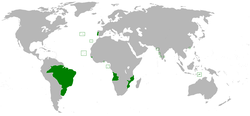Kingdom of Portugal
| Kingdom of Portugal | ||||||||||||||
|
Regnum Portugalliae Reino de Portugal |
||||||||||||||
|
||||||||||||||
|
||||||||||||||
|
Anthem "Hymno Patriótico" (1808–1826) "Patriotic Anthem" Hino da Carta (1826–1910) "Anthem of the Charter" |
||||||||||||||
|
The Kingdom and its empire in 1800
|
||||||||||||||
| Capital |
Coimbra (1139–1255) Lisbon[a] (1255–1808) Rio de Janeiro (1808–21) Lisbon (1821–1910) |
|||||||||||||
| Languages | Official languages: Unofficial languages: | |||||||||||||
| Religion | Majority: Roman Catholicism (official) Minority: Sephardic Judaism Islam |
|||||||||||||
| Government |
Absolute monarchy (1139–1822; 1823–26; 1828–34) Constitutional Monarchy (1822–1823; 1826–28; 1834–1910) |
|||||||||||||
| Monarch | ||||||||||||||
| • | 1139–1185 | Afonso I (first) | ||||||||||||
| • | 1908–1910 | Manuel II (last) | ||||||||||||
| Prime Minister | ||||||||||||||
| • | 1834–1835 | Marquis of Palmela (first) | ||||||||||||
| • | 1910 | Teixeira de Sousa (last) | ||||||||||||
| Legislature | Cortes Gerais | |||||||||||||
| • | Upper house | Chamber of Peers | ||||||||||||
| • | Lower house | Chamber of Deputies | ||||||||||||
| History | ||||||||||||||
| • | Battle of Ourique | 26 July 1139 | ||||||||||||
| • | Restoration of Independence | 1 December 1640 | ||||||||||||
| • | Lisbon Regicide | 1 February 1908 | ||||||||||||
| • | Revolution of 1910 | 5 October 1910 | ||||||||||||
| Area | ||||||||||||||
| • | 1910 (metro) | 92,391 km² (35,672 sq mi) | ||||||||||||
| Population | ||||||||||||||
| • | 1910 (metro) est. | 5,969,056 | ||||||||||||
| Density | 64.6 /km² (167.3 /sq mi) | |||||||||||||
| Currency |
Portuguese dinheiro, (1139–1433) Portuguese real (1433–1910) |
|||||||||||||
|
||||||||||||||
| Today part of |
|
|||||||||||||
| a. ^ The capital was de facto located at Rio de Janeiro from 1808 to 1821. | ||||||||||||||
The Kingdom of Portugal (Latin: Regnum Portugalliae, Portuguese: Reino de Portugal) was a monarchy on the Iberian Peninsula and the predecessor of modern Portugal. It was in existence from 1139 until 1910. After 1248, it was also known as the Kingdom of Portugal and the Algarves and between 1815 and 1822, it was known as the United Kingdom of Portugal, Brazil and the Algarves. The name is also often applied to the Portuguese Empire, the realm's extensive overseas colonies.
The nucleus of the Portuguese state was the County of Portugal, established in the 9th century as part of the Reconquista, by Vímara Peres, a vassal of the King of Asturias. The county became part of the Kingdom of León in 1097, and the Counts of Portugal established themselves as rulers of an independent kingdom in the 12th century, following the battle of São Mamede. The kingdom was ruled by the Alfonsine Dynasty until the 1383–85 Crisis, after which the monarchy passed to the House of Aviz.
During the 15th and 16th century, Portuguese exploration established a vast colonial empire. From 1580 to 1640, the kingdom of Portugal was in personal union with Habsburg Spain.
...
Wikipedia



